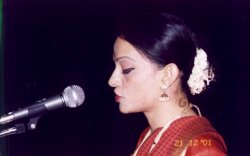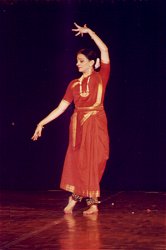
|  |

|  |
Q & A: Audience Artist Interface 21st Natyakala Conference - 2001 Chennai, India DEC 21, 2001 Malavika Sarukkai, Chennai "The Expanding Canvas" Jun 2002  Malavika Sarukkai spoke about "The Expanding Canvas" of Bharatanatyam on the concluding day of the Natya Kala Conference. She performed excerpts from Utkanta to illustrate her points of view on choreography. Utkanta speaks in the voice of the woman. It is the true story of Thimakka, a rural woman of Karnataka who was childless, so she planted 247 banyan trees and created a whole avenue of 'children'.  C V Chandrasekar: I don't know how many of you are aware of the fact that Baroda derives its name originally from Vadodara, a name which it has gone back to. In Gujarati, 'vad' means banyan and 'odara' means belly, from whose belly the banyan tree grew. That's why the city is called Vadodara. Vadodara has lost all its banyan trees, except a few avenues. Seeing what Malavika did in her excerpt from Utkanta, I am sure another Baroda will come up in Karnataka. Are you doing any work with women, any kind of dance themes that will bring out what women are going through in reality? I am not compelled towards it as an issue. Right now, if you ask me if I am working on anything particular, no, I am not. There are so many impressions one takes back, like the September 11th violence. I am sure we as artistes, as human beings can help the people inch back to a life they cannot accept. The work should speak to them, it has to communicate. I think it shows the different pity levels. Right now, I think there's great sorrow and despondency and I am sort of exploring those emotions. Why were you shedding tears when you were doing Thimakka? Through action or acting? Through action! I don't know…or was it through acting? In action, because it is such a grief for her to come to terms with her infertility. Her spirit is broken. Therefore the meeting imposes that in her, it changes her world, transforms her and from the emptiness of her womb, she hears the sound within the earth which is her womb. It's her fate. I thought she was walking the earth with her fears? I think perhaps there have been other interpretations; it's not just one way. Rasikas, you are welcome to have your judgment of the piece. This is how I feel and that's what I did. What is your process in choreographing works? Your mental process, do you have an idea, are you inspired by something? How do you actually develop it, conceive the movement. Do you experiment? How do you choreograph your piece? It's like a seed, which is sown in the earth. It takes a long time to grow and flower, sometimes even months. So also with ideas. We carry a lot of ideas and at some point it flowers. First of all, we get fired by a concept and then a piece is inspired by it. This will be followed by long discussions with my mother who is also my great collaborator. We discuss the concept, the way it's going. I was very fortunate to have Mrs. Seshadri to write the lyrics and Chandru anna (C V Chandrasekar) here to whom I can say, "This is what I have in mind, please make the music for it". Being the kind of composer he is, he would come up with different possibilities and then comes the question of my prowess. Sitting on an item for hours together and visualizing the movements… no movement comes just like that. The labor process is deliberate and slow paced. It's not something spontaneous, something happening in my mind. It's very worked out, otherwise you will not get the visual that you see. Then it's hours of composing, clarifying, calculating, deleting, internalizing before it finally goes to the audience. How do you view contemporary dance as we see it today, your impressions, if you agree or disagree, or let it be, and you go your way? What do you mean by contemporary? Not modern, but contemporary for Bharatanatyam, an extension of Bharatanatyam with newer ideas. As an artiste, I can say explorations are fine because one has to explore. I think what one must keep in mind is whether the dance speaks. I think sometimes nowadays, one intellectualizes too much and it's all very conceptual. It's all up there in the head and then you wonder, is it really happening in the dance because dance is a visual form and that should speak. Or else, there's no point. Is it that you draw a line between expression and communication? You can express anything but it has to communicate to make sense. To attempt a new work is extremely difficult. I really believe it requires years of internalizing before one can choreograph and a lot of imagination and technique and I think an artist should have all this within one. Then, as if in one stroke, one can communicate. I am not sure it happens all the time, but I think after the show is over, a dancer should look within one's soul. Because it's a great truth to communicate, we should see firstly if we are intellectualizing too much. Secondly, are we getting across to the audience? Do they feel what we think? I think we have to ask all these questions and it's not wrong to ask all these questions. There's a tendency to feel that as a prototype, that is all that we did in the usual / visual work. I think physically if you feel something, you have to communicate it and dance is meant to communicate. And when both don't communicate, some of you are falling short. The dancers are now receiving training in so many things and I think it's important for the art form. I spoke about it even in Rasa. I really believe those are breeding blocks as it were, which one has to hold firm and hold with humility before one ventures. The idea of a tree or creeper and Krishna and Radha under that... When an idea is there, you want to expand something that could happen in a few seconds to a 30 or 45 minute piece. What facts do you store and how do you expand your idea from that store? What you would call modern Bharatanatyam, your way of presenting an idea in a particular way, like how a leaf or branch moves, if a breeze is light or cool. I just feel as a woman and artist that we are generally drawn towards what we know is close to us. The tree was not the central force. Perhaps the emphasis we give, the elaboration in its entirety is different. It took a temporary energy in a way because I think it has to connect a visual to me as well as to another person. It is actually very difficult to do something totally new. Q & A: Audience Artist Interface 21st Natyakala Conference - 2001 |